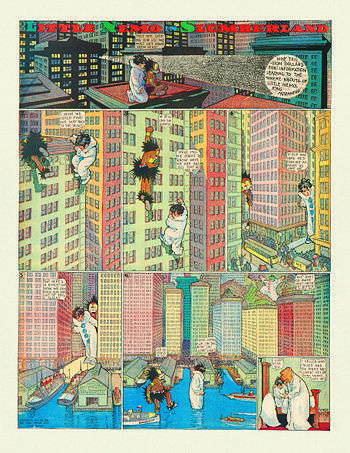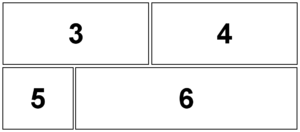Sunday comics

The Sunday comics is the full-color comic strip section carried in most American newspapers. Many newspaper readers called this section the Sunday funnies, the funny papers or simply the funnies.[1]
The first US newspaper comic strips appeared in the late 19th century, closely allied with the invention of the color press.[2] Jimmy Swinnerton's The Little Bears introduced sequential art and recurring characters in William Randolph Hearst's San Francisco Examiner. In America, the popularity of color comic strips sprang from the newspaper war between Hearst and Joseph Pulitzer.
Role of the color press
After the publisher of the Chicago Inter-Ocean saw the first color press in Paris at the offices of Le Petit Journal, he had his own color press operating late in 1892.[3] At the New York Recorder, manager George Turner had R. Hoe & Co. design a color press, and the Recorder published the first American newspaper color page on April 2, 1893. The following month, Pulitzer's New York World printed cartoonist Walt McDougall's "The Possibilities of the Broadway Cable Car" as a color page on May 21, 1893. In 1894, Pulitzer introduced the Sunday color supplement.
The Yellow Kid is usually credited as one of the first US newspaper comic strips. However, the artform combining words and pictures evolved gradually, and there are many examples of proto-comic strips. In 1995, King Features Syndicate president Joseph F. D'Angelo wrote:
- It was in Joseph Pulitzer's New York World that cartoonist Richard Outcault's legendary Yellow Kid made his newspaper debut in 1895, but it was Hearst's New York Journal that cannily snatched the Kid away from the rival sheet and deployed him as a key weapon in the historic newspaper circulation wars. The Kid led the charge in Hearst's trailblazing American Humorist comic supplement, with its famous motto: "Eight Pages of Iridescent Polychromous Effulgence That Makes The Rainbow Look Like A Lead Pipe!" Pulitzer fought back by hiring another artist to draw Outcault's character for the World. The publishers' fierce battle over the bald urchin in the yellow nightshirt led bystanders to refer to sensational, screaming-headline style newspaper combat as "yellow journalism." The popularity of that expression tainted the early comics as a less-than-genteel entertainment, but it also made it clear that the "funnies" had become serious business, seemingly overnight.[4]
In 1905, Winsor McCay's Little Nemo in Slumberland began. Stephen Becker, in Comic Art in America, noted that Little Nemo in Slumberland was "probably the first strip to exploit color for purely aesthetic purposes; it was the first in which the dialogue, occasionally polysyllabic, flirted with adult irony.[3]
By 1906, the weekly Sunday comics supplement was commonplace, with a half-dozen competitive syndicates circulating strips to newspapers in every major American city. In 1923, The Commercial Appeal in Memphis, Tennessee, became among the first in the nation to acquire its own radio station, and it was the first Southern newspaper to publish a Sunday comic section.[5]
For most of the 20th century, the Sunday funnies were a family tradition, enjoyed each weekend by adults and kids alike. They were read by millions and produced famous fictional characters in such strips as Flash Gordon, Little Orphan Annie, Prince Valiant, Dick Tracy and Terry and the Pirates. Leading the lists of classic humor strips are Bringing Up Father, Gasoline Alley, Li'l Abner, Pogo, Peanuts and Smokey Stover. Some newspapers added their own local features, such as Our Own Oddities in the St. Louis Post-Dispatch. There were educational strips, such as King Features' Heroes of American History. In addition to the comic strips, Sunday comics sections also carried advertisements in a comics format, single-panel features, puzzles, paper dolls and cut-and-paste activities. The World Museum gave readers instructions for cutting pictures apart and assembling them into a diorama, often with a subject from nature, such as The Grand Canyon or Buffalo Hunt. A page on covered wagons carried the headline, "Covered wagons shown in an easy-to-build model: Scissors, paste and wrapping paper are all you need to make this Western set."
Some radio stations across the United States featured Sunday morning programs in which an announcer read aloud from the Sunday comics section, allowing readers to follow action in the panels as they listened to the dialogue. Most notably, on July 8, 1945, during a New York newspaper deliverers' strike, New York mayor Fiorello H. La Guardia read comic strips over the radio.
Sunday strip layout
Early Sunday strips filled an entire newspaper page. Later strips, such as The Phantom and Terry and the Pirates, were usually only half that size, with two strips to a page in full-size newspapers, such as the New Orleans Times Picayune, or with one strip on a tabloid page, as in the Chicago Sun-Times.[7] When Sunday strips began to appear in more than one format, it became necessary for the cartoonist to follow a standardized strip layout, which provides newspapers with the greatest flexibility in determining how to print a strip.[6] One notable distinction among Sunday comics supplements was the supplement produced in a comic book-like format, featuring the character The Spirit. These sixteen-page (later 8 page) standalone Sunday supplements of Will Eisner's character were included with newspapers from 1940 through 1952. During World War II, because of paper shortages, the size of Sunday strips began to shrink. After the war, strips continued to get smaller and smaller, to save the expense of printing so many color pages. The last full-page comic strip was the Prince Valiant strip for 11 April 1971. The dimensions of the Sunday comics continued to decrease in recent years, as did the number of pages. Sunday comics sections that were 10 or 12 pages in 1950 dropped to six or four pages by 2005. One of the last large-size Sunday comics in the United States is in the Reading Eagle, which has eight Berliner-size pages and carries 36 comics. It's banner headline is "Biggest Comics Section in the Land".[7] Another big-size comic section is that of The Washington Post which carries 41 strips in eight broadsheet pages although it also contains a sudoku and a Jumble puzzle. Canadian newspaper comic sections are unique not only because of being printed on Saturdays, but these usually are also part of the entertainment or lifestyle section. A notable exception is that of the Winnipeg Free Press which publishes an eight-page comic-only tabloid section.
In some cases today, the daily strip and Sunday strip dimensions are almost the same. For instance, a daily strip in The Arizona Republic measures 4 3⁄4" wide by 1 1⁄2" deep, while the three-tiered Hägar the Horrible Sunday strip in the same paper is 5" wide by 3 3⁄8" deep.
See also
- Comics
- Daily strip
- Graphic novels
- List of comic strip syndicates
- List of newspaper comic strips
- Sunday strip
References
- ↑ "funnies". Random House Webster's Unabridged Dictionary.
- ↑ Robinson, Jerry (1974). The Comics: An Illustrated History of Comic Strip Art. G. P. Putnam's Sons.
- 1 2 Becker, Stephen. Comic Art in America. Simon & Schuster, 1959.
- ↑ "William Randolph Hearst and the Comics"
- ↑ The Tennessee Encyclopedia of History and Culture
- 1 2 3 4 Watterson, Bill (1995). Calvin and Hobbes Tenth Anniversary Book. Andrews and McMeel. pp. 14–15. ISBN 0-8362-0438-7.
- 1 2 Holtz, Allan. Stripper's Guide Dictionary Part 1: Sunday Strips, August 14, 2007.
Further reading
- Horn, Maurice, The World Encyclopedia of Comics (1976) Chelsea House, (1982) Avon
- Blackbeard, Bill and Dale Crain, The Comic Strip Century, Kitchen Sink Press, 1995. ISBN 0-87816-355-7
- Blackbeard, Bill and Martin Williams, The Smithsonian Collection of Newspaper Comics, Smithsonian Institution Press and Harry N. Abrams, 1977. ISBN 0-8109-2081-6
- Koenigsberg, Moses. King News, Moses Koenigsberg



